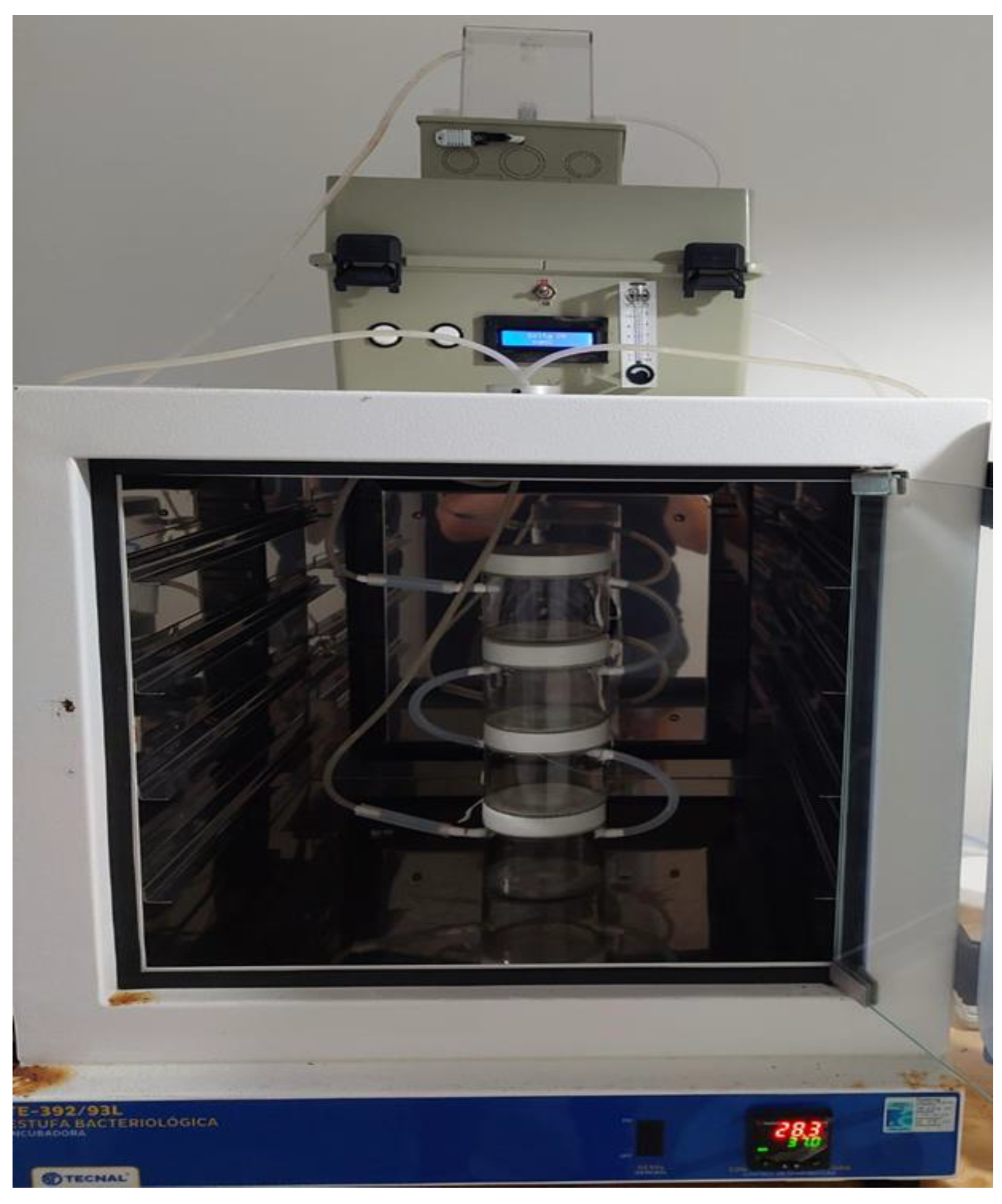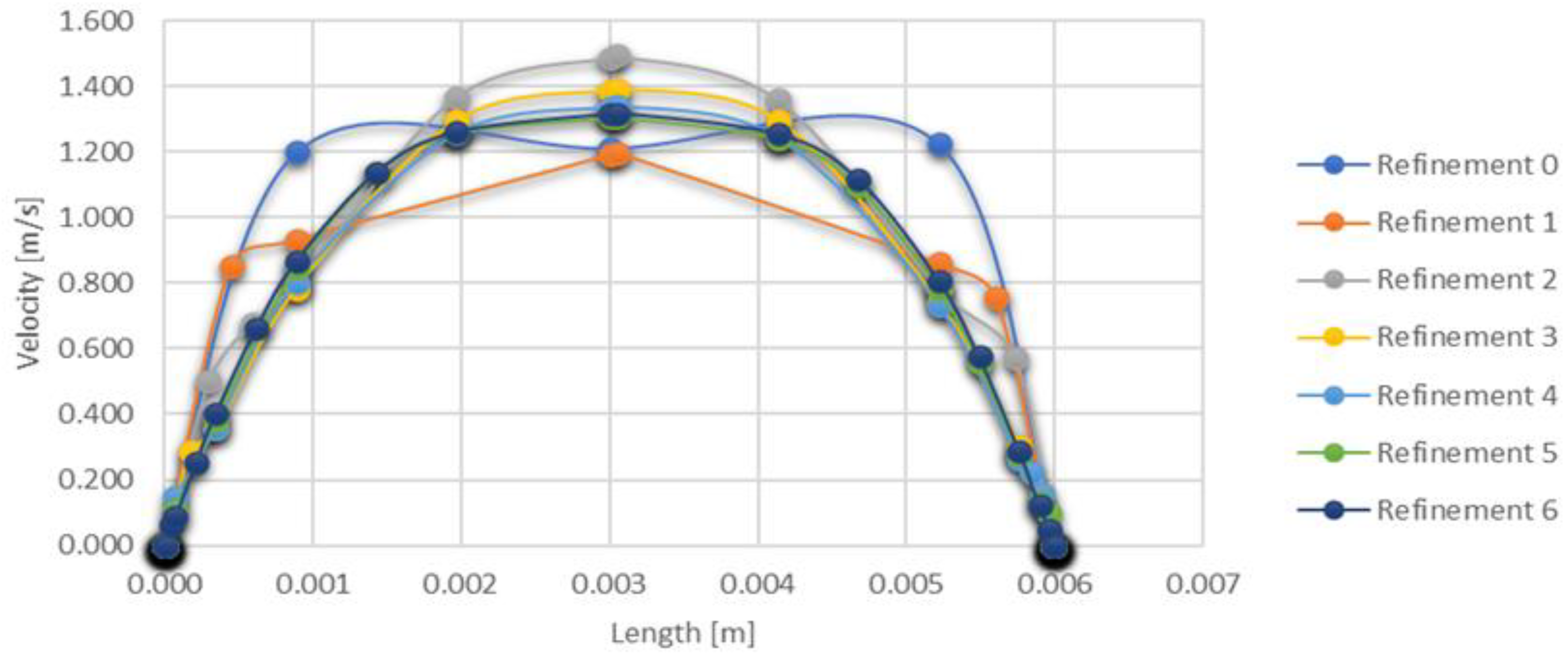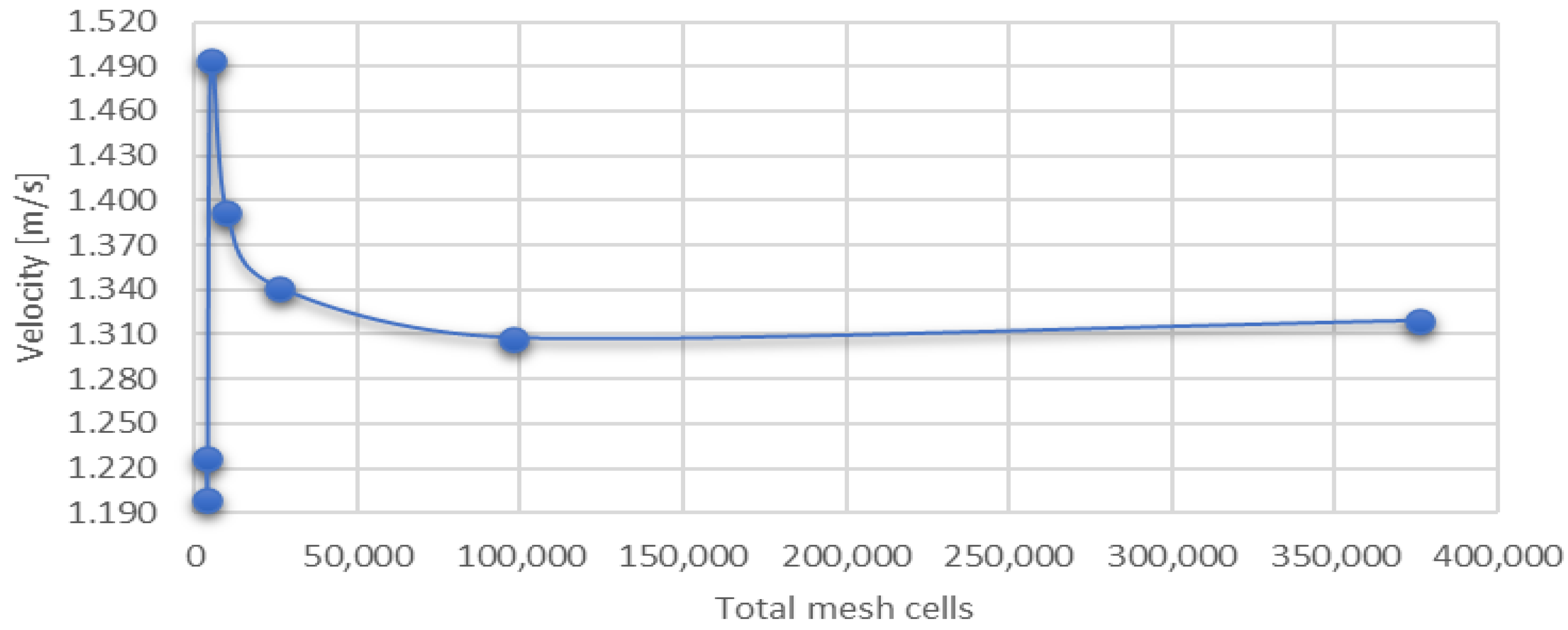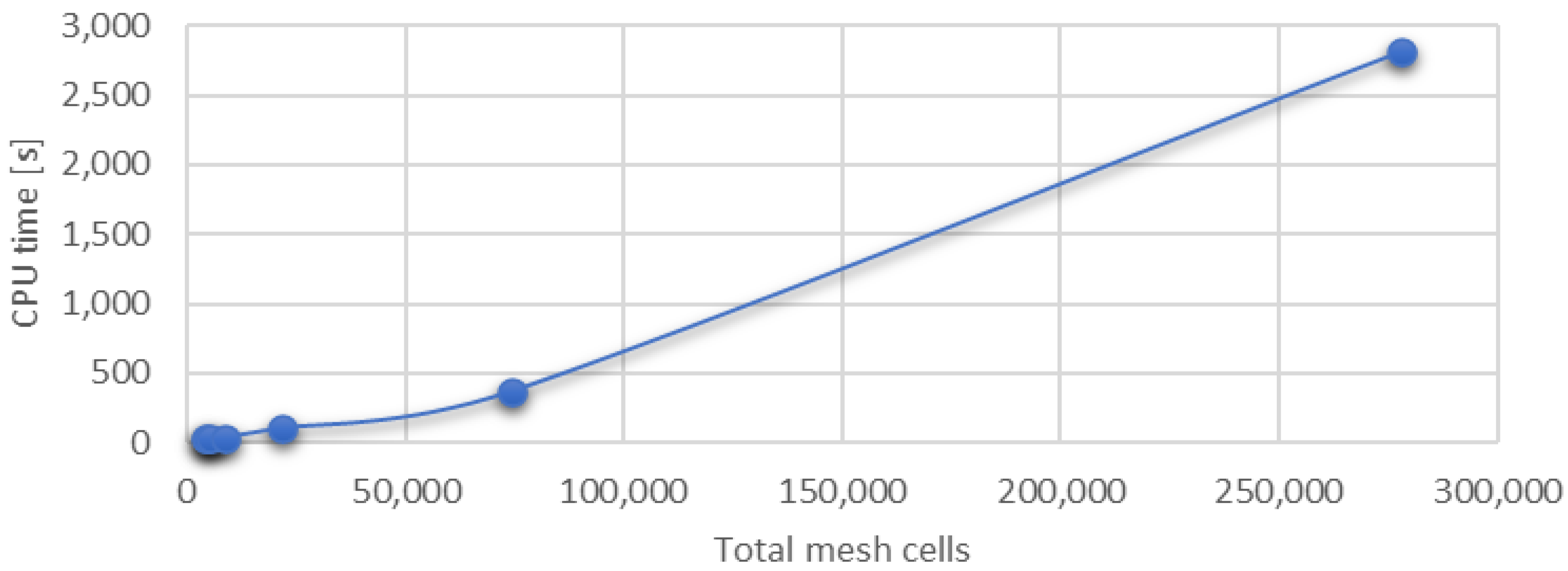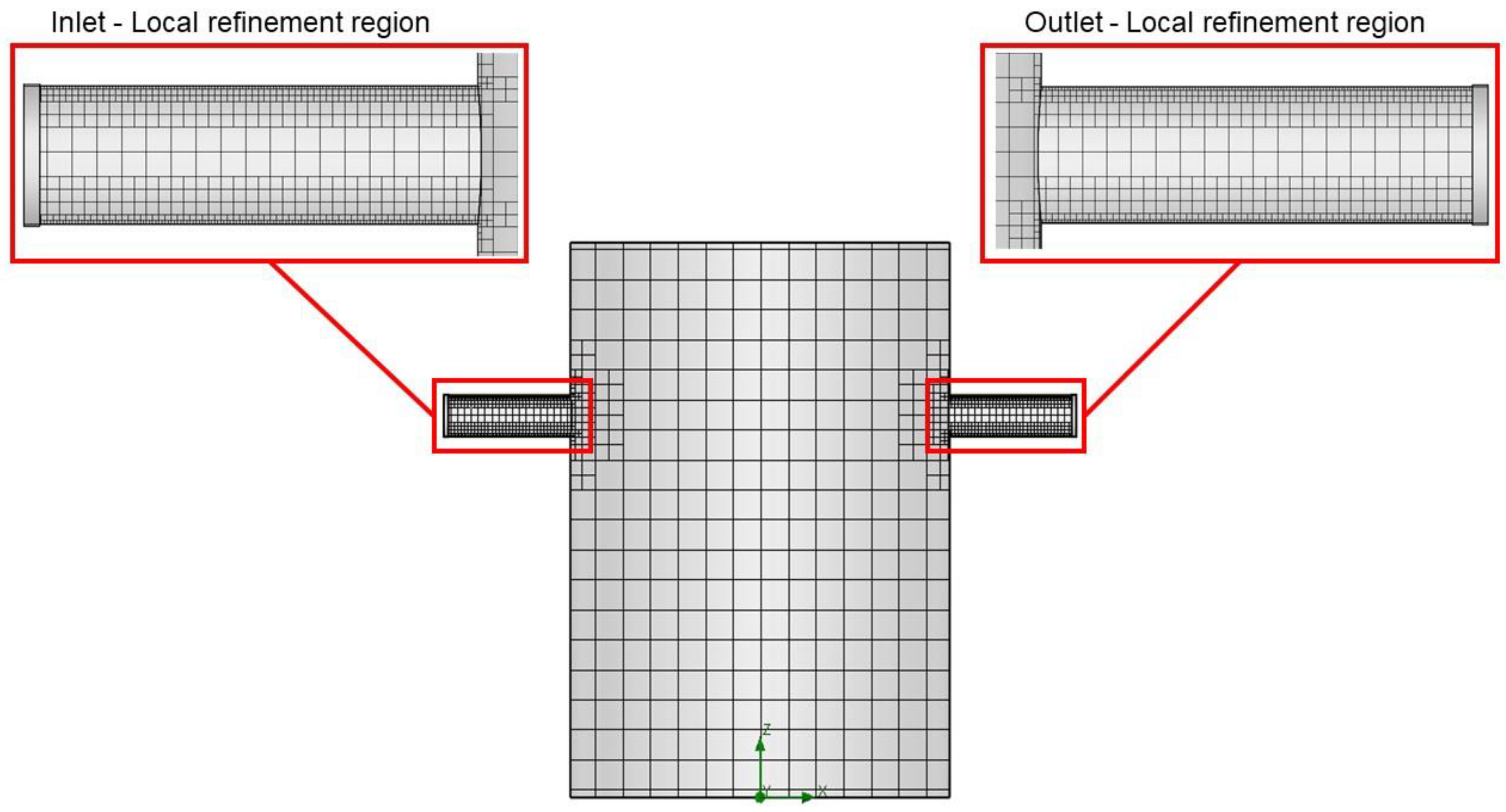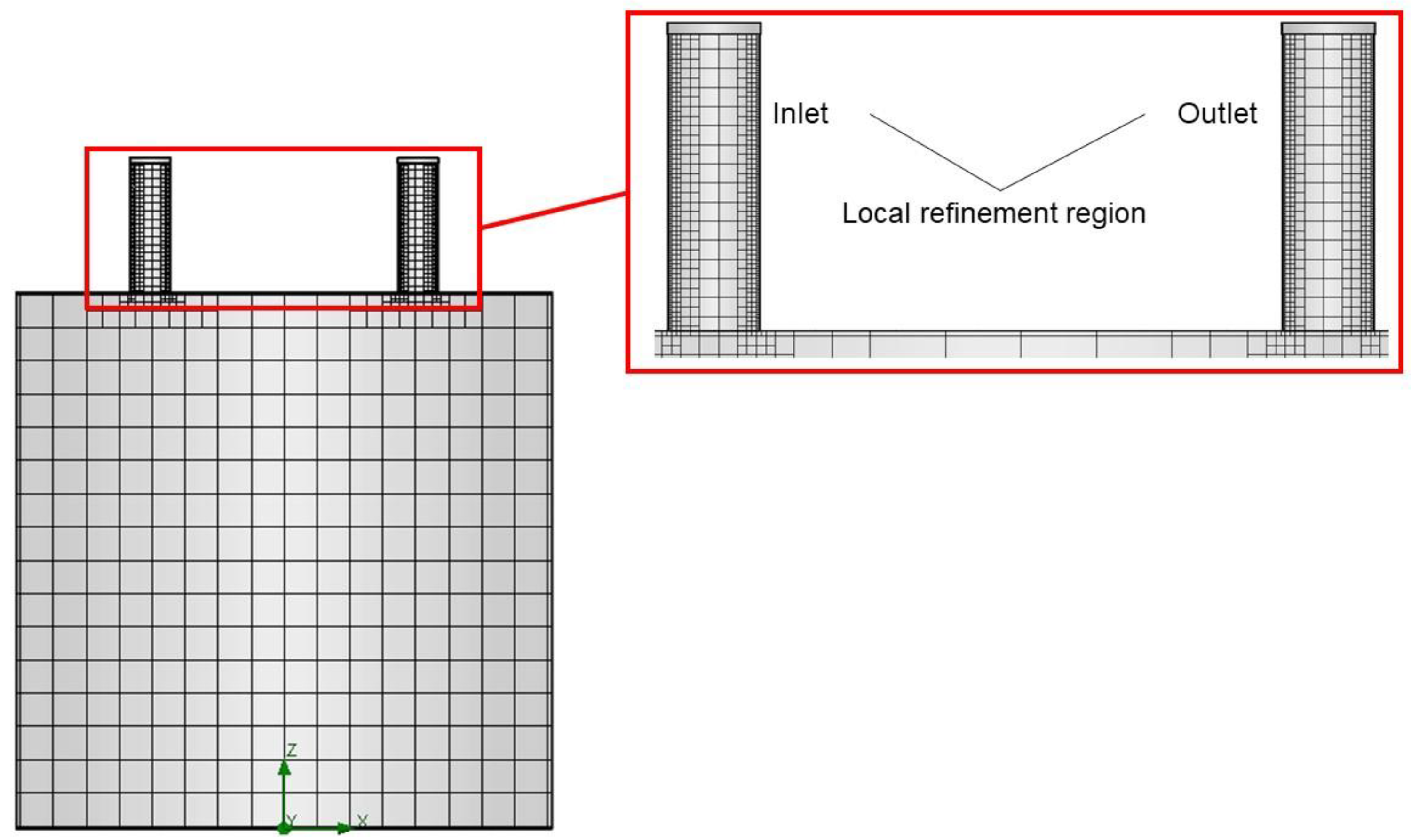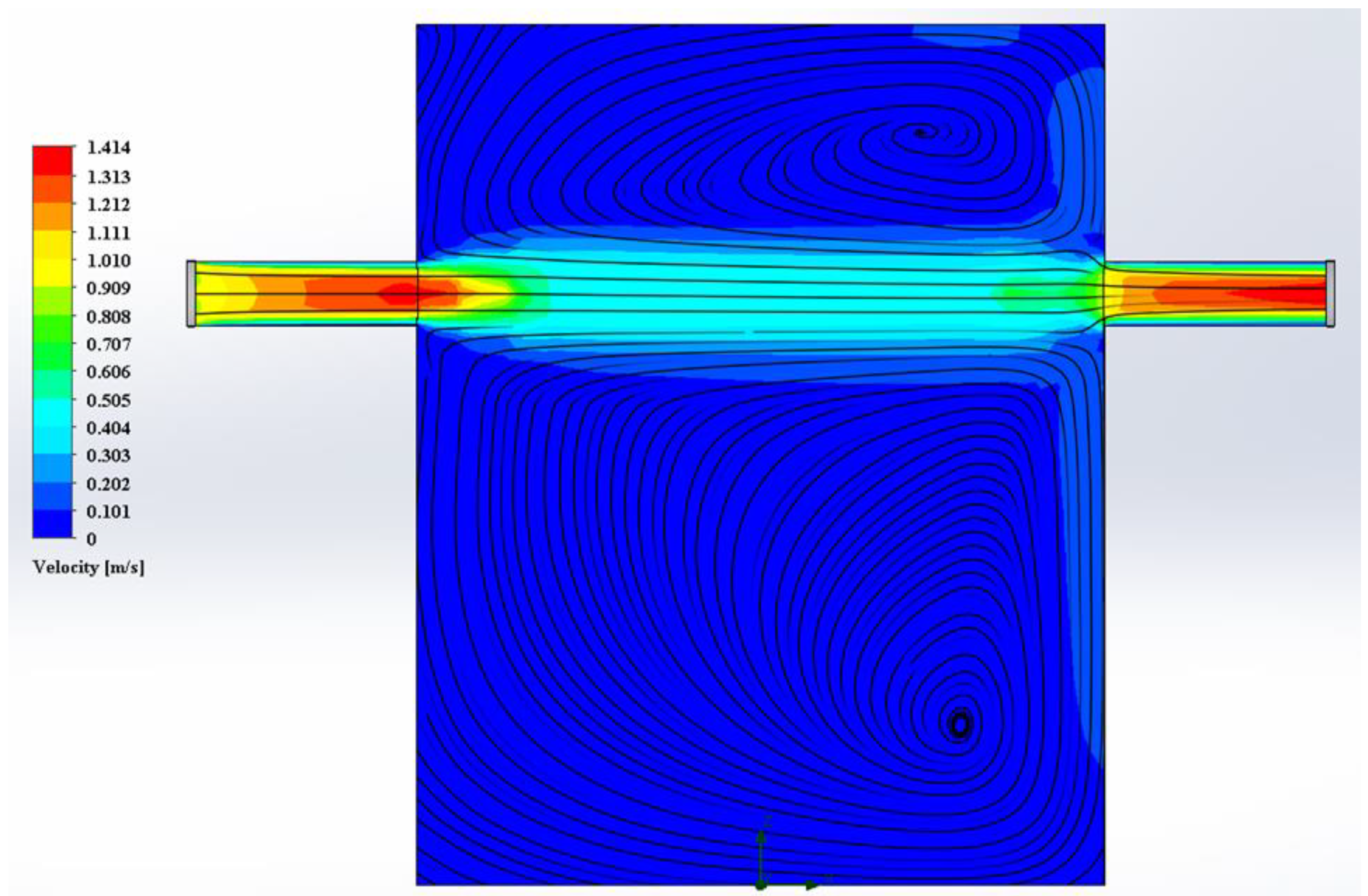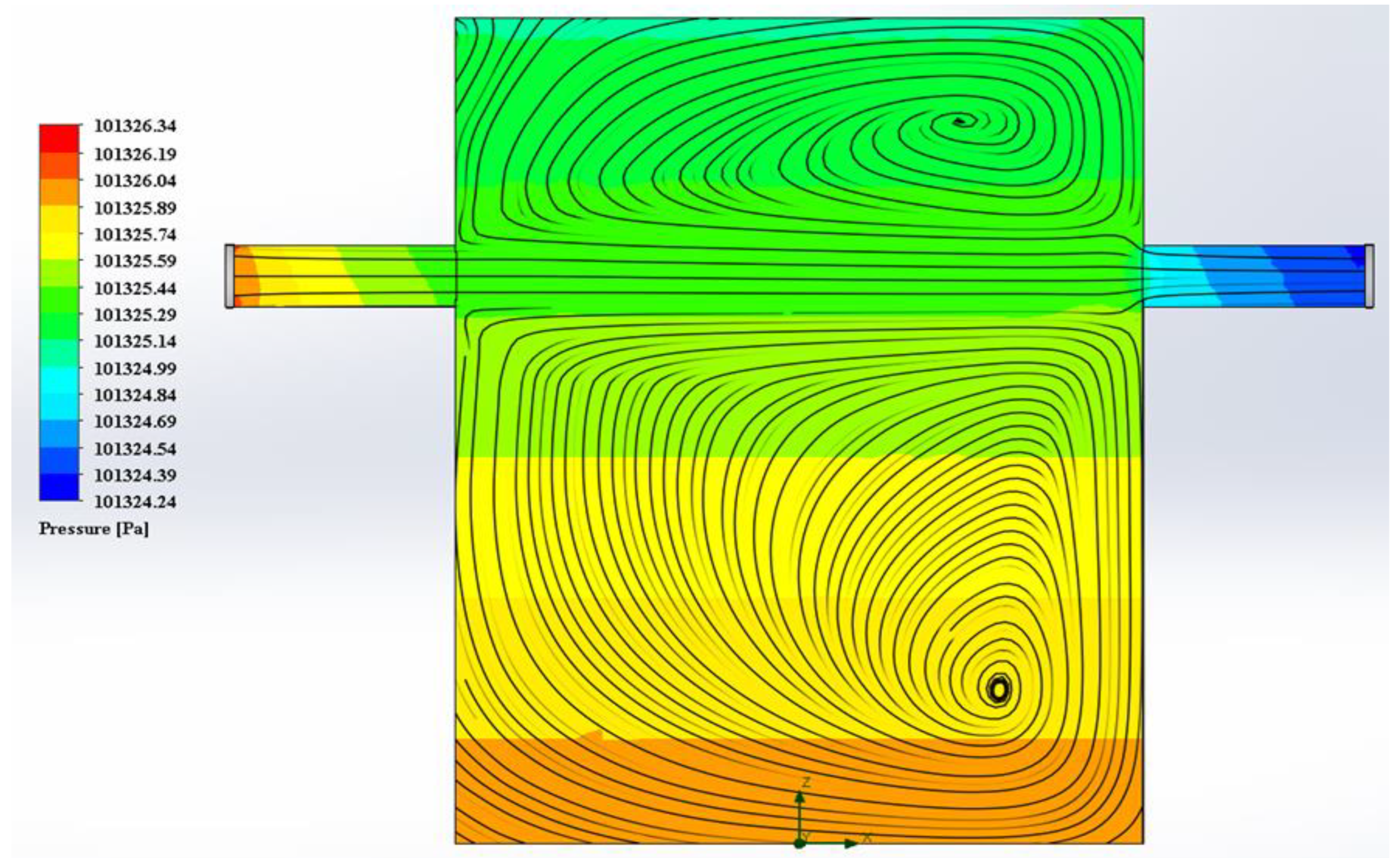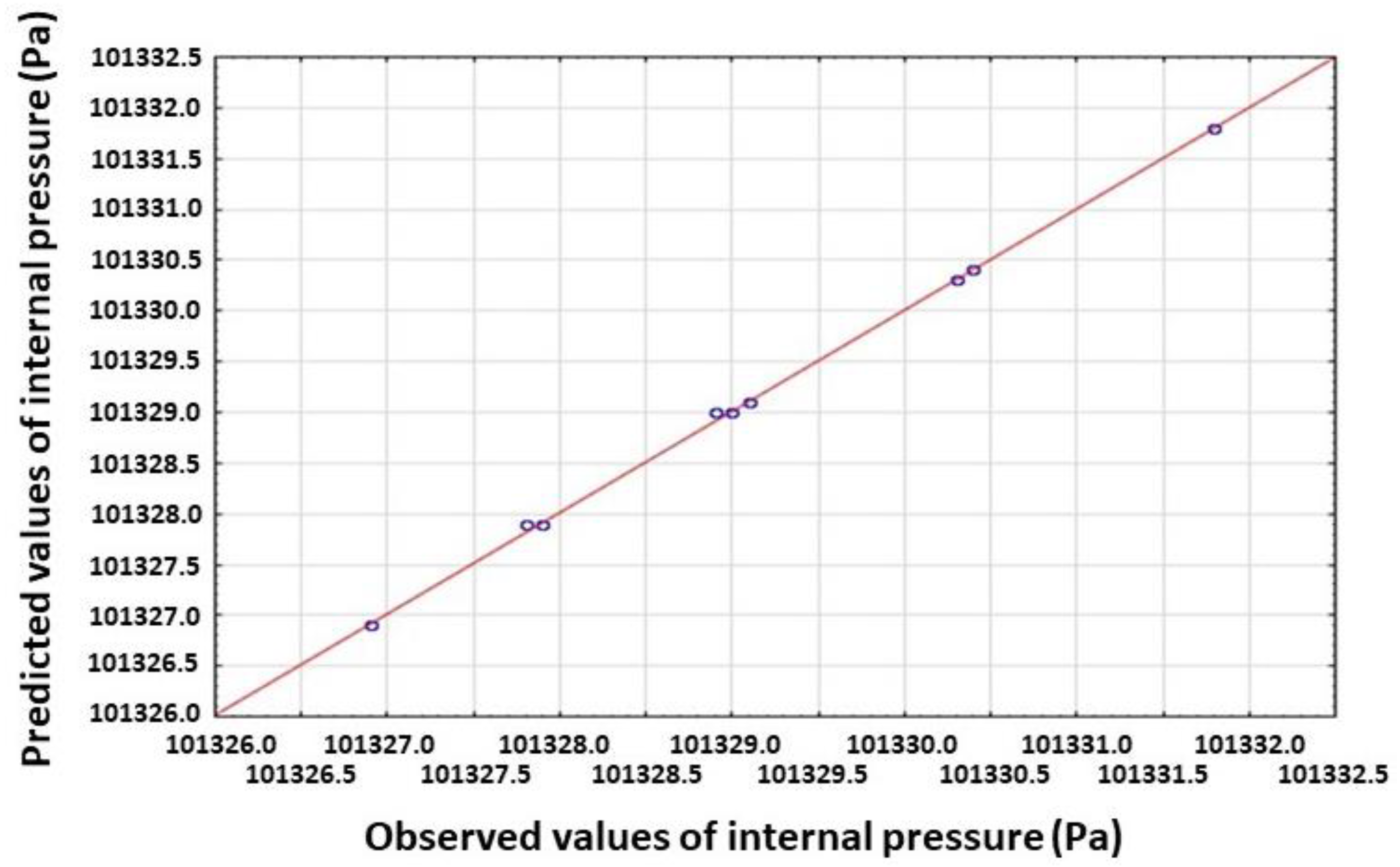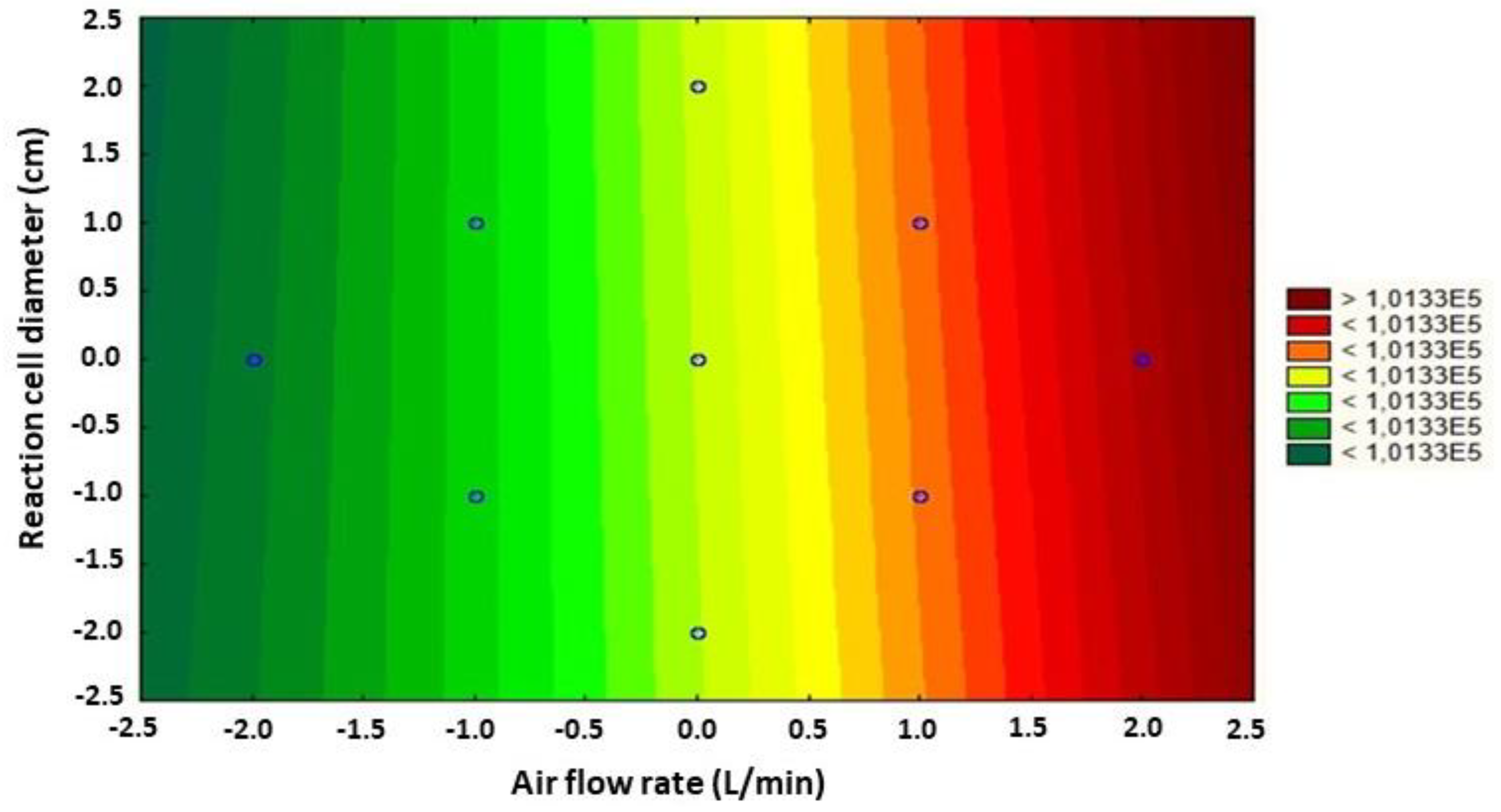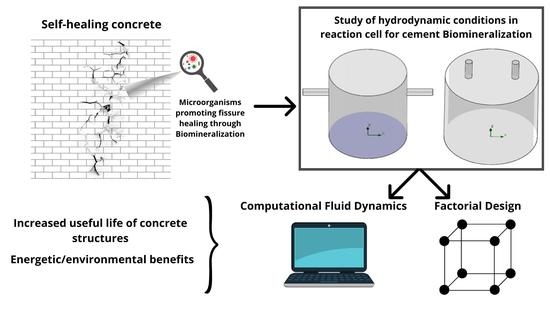Author Contributions
Conceptualization, B.A.C.R.; methodology, B.A.C.R. and P.P.F.B.; formal analysis, B.A.C.R.; investigation, B.A.C.R.; resources, L.A.S.; data curation, B.A.C.R.; writing—original draft preparation, B.A.C.R., P.P.F.B., M.B. and L.A.S.; writing—review and editing, B.A.C.R., P.P.F.B., H.J.B.d.L.F., A.C., B.A., M.B. and L.A.S.; visualization, B.A.C.R.; supervision, M.B. and L.A.S.; project administration, Y.B.B., M.B. and L.A.S.; funding acquisition, A.C., B.A., M.B. and L.A.S. All authors have read and agreed to the published version of the manuscript.
Figure 1.
Cascade system used to perform biomineralization in cement.
Figure 1.
Cascade system used to perform biomineralization in cement.
Figure 3.
(a) Model of geometry of lateral inlet and outlet with line traced to 1 cm from the end of the air outlet tube; (b) Model of geometry of upper inlet and outlet with line traced to 1 cm from the end of the air outlet tube.
Figure 3.
(a) Model of geometry of lateral inlet and outlet with line traced to 1 cm from the end of the air outlet tube; (b) Model of geometry of upper inlet and outlet with line traced to 1 cm from the end of the air outlet tube.
Figure 4.
(a) Model of geometry with lateral inlet and outlet with line drawn at 7 cm from the upper region of reaction cell; (b) Model of geometry with upper inlet and outlet with line drawn at 7 cm from the upper region of reaction cell.
Figure 4.
(a) Model of geometry with lateral inlet and outlet with line drawn at 7 cm from the upper region of reaction cell; (b) Model of geometry with upper inlet and outlet with line drawn at 7 cm from the upper region of reaction cell.
Figure 5.
Velocity versus length for different mesh refinements for geometry with lateral air inlet and outlet.
Figure 5.
Velocity versus length for different mesh refinements for geometry with lateral air inlet and outlet.
Figure 6.
Velocity versus length for different mesh refinements for the geometry with upper air inlet and outlet.
Figure 6.
Velocity versus length for different mesh refinements for the geometry with upper air inlet and outlet.
Figure 7.
Maximum velocity of each refinement versus total number of mesh cells for the geometry with lateral air inlet and outlet.
Figure 7.
Maximum velocity of each refinement versus total number of mesh cells for the geometry with lateral air inlet and outlet.
Figure 8.
Maximum velocity of each refinement versus total number of mesh cells for the geometry with upper air inlet and outlet.
Figure 8.
Maximum velocity of each refinement versus total number of mesh cells for the geometry with upper air inlet and outlet.
Figure 9.
Time of central processing unit (CPU) versus total number of mesh cells for the geometry with lateral air inlet and outlet.
Figure 9.
Time of central processing unit (CPU) versus total number of mesh cells for the geometry with lateral air inlet and outlet.
Figure 10.
Time of central processing unit (CPU) versus total number of mesh cells for the geometry with upper air inlet and outlet.
Figure 10.
Time of central processing unit (CPU) versus total number of mesh cells for the geometry with upper air inlet and outlet.
Figure 11.
Representation of mesh created after definition of global and local meshes for the geometry with lateral air inlet and outlet.
Figure 11.
Representation of mesh created after definition of global and local meshes for the geometry with lateral air inlet and outlet.
Figure 12.
Representation of mesh created after definition of global and local meshes for the geometry with upper air inlet and outlet.
Figure 12.
Representation of mesh created after definition of global and local meshes for the geometry with upper air inlet and outlet.
Figure 13.
Air velocity in reaction cell and current lines, in run 1, for the geometry with lateral air inlet and outlet. Q = 1.5 L/min; = 6.0 cm; = 2.5 cm; = 2.5 cm.
Figure 13.
Air velocity in reaction cell and current lines, in run 1, for the geometry with lateral air inlet and outlet. Q = 1.5 L/min; = 6.0 cm; = 2.5 cm; = 2.5 cm.
Figure 14.
Air velocity in reaction cell and current lines, in run 1, for the geometry with upper air inlet and outlet. Q = 2.5 L/min; = 8.0 cm; = 2.0 cm; = 2.0 cm.
Figure 14.
Air velocity in reaction cell and current lines, in run 1, for the geometry with upper air inlet and outlet. Q = 2.5 L/min; = 8.0 cm; = 2.0 cm; = 2.0 cm.
Figure 15.
Internal pressure in the reaction cell and current lines, in run 1, for the geometry with lateral air inlet and outlet. Q = 1.5 L/min; = 6.0 cm; = 2.5 cm; = 2.5 cm.
Figure 15.
Internal pressure in the reaction cell and current lines, in run 1, for the geometry with lateral air inlet and outlet. Q = 1.5 L/min; = 6.0 cm; = 2.5 cm; = 2.5 cm.
Figure 16.
Internal pressure in the reaction cell and current lines, in run 1, for the geometry with upper air inlet and outlet. Q = 2.5 L/min; = 8.0 cm; = 2.0 cm; = 2.0 cm.
Figure 16.
Internal pressure in the reaction cell and current lines, in run 1, for the geometry with upper air inlet and outlet. Q = 2.5 L/min; = 8.0 cm; = 2.0 cm; = 2.0 cm.
Figure 17.
Predicted versus observed values of air velocity in the reaction cell with lateral air inlet and outlet geometry.
Figure 17.
Predicted versus observed values of air velocity in the reaction cell with lateral air inlet and outlet geometry.
Figure 18.
2D contour graph of the interaction effects for the lateral air inlet and outlet geometry. Simultaneous effects on velocity exerted by (a) distance of air inlet and air flow rate; (b) distance of air outlet and air flow rate; (c) distance of air inlet and distance of air outlet.
Figure 18.
2D contour graph of the interaction effects for the lateral air inlet and outlet geometry. Simultaneous effects on velocity exerted by (a) distance of air inlet and air flow rate; (b) distance of air outlet and air flow rate; (c) distance of air inlet and distance of air outlet.
Figure 19.
Predicted versus observed values of internal pressure in the reaction cell with lateral air inlet and outlet geometry.
Figure 19.
Predicted versus observed values of internal pressure in the reaction cell with lateral air inlet and outlet geometry.
Figure 20.
2D contour graph of the interaction effects for the lateral air inlet and outlet geometry. Simultaneous effects on internal pressure exerted by (a) distance of air inlet and air flow rate; (b) distance of air outlet and air flow rate; (c) distance of air inlet and distance of air outlet.
Figure 20.
2D contour graph of the interaction effects for the lateral air inlet and outlet geometry. Simultaneous effects on internal pressure exerted by (a) distance of air inlet and air flow rate; (b) distance of air outlet and air flow rate; (c) distance of air inlet and distance of air outlet.
Figure 21.
Predicted versus observed values of air velocity in the reaction cell with upper air inlet and outlet geometry.
Figure 21.
Predicted versus observed values of air velocity in the reaction cell with upper air inlet and outlet geometry.
Figure 22.
2D contour graph of interaction effects for the upper air inlet and outlet geometry. Simultaneous effects on velocity exerted by (a) reaction cell diameter and air flow rate; (b) distance of air inlet and air flow rate; (c) distance of air inlet and reaction cell diameter.
Figure 22.
2D contour graph of interaction effects for the upper air inlet and outlet geometry. Simultaneous effects on velocity exerted by (a) reaction cell diameter and air flow rate; (b) distance of air inlet and air flow rate; (c) distance of air inlet and reaction cell diameter.
Figure 23.
Predicted versus observed values of internal pressure in the reaction cell with upper air inlet and outlet geometry.
Figure 23.
Predicted versus observed values of internal pressure in the reaction cell with upper air inlet and outlet geometry.
Figure 24.
2D contour graph of interaction effects of reaction cell diameter and air flow rate on the internal pressure for the upper air inlet and outlet geometry.
Figure 24.
2D contour graph of interaction effects of reaction cell diameter and air flow rate on the internal pressure for the upper air inlet and outlet geometry.
Table 1.
Standard construction dimensions used for reaction cells.
Table 1.
Standard construction dimensions used for reaction cells.
| Standard Dimensions | Size (cm) |
|---|
| Total height of reaction cell | 8.0 |
| Length of air inlets and outlets | 2.0 |
| Diameter of air inlet and outlet tubes | 0.6 |
| Wall thickness | 0.001 |
Table 2.
Matrix of levels used in the factorial design for the lateral inlet and outlet configuration.
Table 2.
Matrix of levels used in the factorial design for the lateral inlet and outlet configuration.
| Level | Q (L/min) | (cm)
| (cm)
| (cm)
|
|---|
| −2.00 | 1.0 | 5.0 | 2.0 | 2.0 |
| −1.00 | 1.5 | 6.0 | 2.5 | 2.5 |
| 0.00 | 2.0 | 7.0 | 3.0 | 3.0 |
| 1.00 | 2.5 | 8.0 | 3.5 | 3.5 |
| 2.00 | 3.0 | 9.0 | 4.0 | 4.0 |
Table 3.
Matrix of runs performed according to the lateral inlet and outlet factorial design.
Table 3.
Matrix of runs performed according to the lateral inlet and outlet factorial design.
| Run | Q (L/min) | (cm)
| (cm)
| (cm)
|
|---|
| 1 | 1.5 | 6.0 | 2.5 | 2.5 |
| 2 | 2.5 | 6.0 | 2.5 | 2.5 |
| 3 | 1.5 | 8.0 | 2.5 | 2.5 |
| 4 | 2.5 | 8.0 | 2.5 | 2.5 |
| 5 | 1.5 | 6.0 | 3.5 | 2.5 |
| 6 | 2.5 | 6.0 | 3.5 | 2.5 |
| 7 | 1.5 | 8.0 | 3.5 | 2.5 |
| 8 | 2.5 | 8.0 | 3.5 | 2.5 |
| 9 | 1.5 | 6.0 | 2.5 | 3.5 |
| 10 | 2.5 | 6.0 | 2.5 | 3.5 |
| 11 | 1.5 | 8.0 | 2.5 | 3.5 |
| 12 | 2.5 | 8.0 | 2.5 | 3.5 |
| 13 | 1.5 | 6.0 | 3.5 | 3.5 |
| 14 | 2.5 | 6.0 | 3.5 | 3.5 |
| 15 | 1.5 | 8.0 | 3.5 | 3.5 |
| 16 | 2.5 | 8.0 | 3.5 | 3.5 |
| 17 | 1.0 | 7.0 | 3.0 | 3.0 |
| 18 | 3.0 | 7.0 | 3.0 | 3.0 |
| 19 | 2.0 | 5.0 | 3.0 | 3.0 |
| 20 | 2.0 | 9.0 | 3.0 | 3.0 |
| 21 | 2.0 | 7.0 | 2.0 | 3.0 |
| 22 | 2.0 | 7.0 | 4.0 | 3.0 |
| 23 | 2.0 | 7.0 | 3.0 | 2.0 |
| 24 | 2.0 | 7.0 | 3.0 | 4.0 |
| 25 | 2.0 | 7.0 | 3.0 | 3.0 |
Table 4.
Matrix of levels used in the factorial design for the upper inlet and outlet configuration.
Table 4.
Matrix of levels used in the factorial design for the upper inlet and outlet configuration.
| Level | Q (L/min) | (cm)
| (cm)
| (cm)
|
|---|
| −2.00 | 2.0 | 7.0 | 1.75 | 1.75 |
| −1.00 | 2.5 | 8.0 | 2.00 | 2.00 |
| 0.00 | 3.0 | 9.0 | 2.25 | 2.25 |
| 1.00 | 3.5 | 10.0 | 2.50 | 2.50 |
| 2.00 | 4.0 | 11.0 | 2.75 | 2.75 |
Table 5.
Matrix of runs performed according to the upper inlet and outlet factorial design.
Table 5.
Matrix of runs performed according to the upper inlet and outlet factorial design.
| Run | Q (L/min) | (cm)
| (cm)
| (cm)
|
|---|
| 1 | 2.5 | 8.0 | 2.00 | 2.00 |
| 2 | 3.5 | 8.0 | 2.00 | 2.00 |
| 3 | 2.5 | 10.0 | 2.00 | 2.00 |
| 4 | 3.5 | 10.0 | 2.00 | 2.00 |
| 5 | 2.5 | 8.0 | 2.50 | 2.00 |
| 6 | 3.5 | 8.0 | 2.50 | 2.00 |
| 7 | 2.5 | 10.0 | 2.50 | 2.00 |
| 8 | 3.5 | 10.0 | 2.50 | 2.00 |
| 9 | 2.5 | 8.0 | 2.00 | 2.50 |
| 10 | 3.5 | 8.0 | 2.00 | 2.50 |
| 11 | 2.5 | 10.0 | 2.00 | 2.50 |
| 12 | 3.5 | 10.0 | 2.00 | 2.50 |
| 13 | 2.5 | 8.0 | 2.50 | 2.50 |
| 14 | 3.5 | 8.0 | 2.50 | 2.50 |
| 15 | 2.5 | 10.0 | 2.50 | 2.50 |
| 16 | 3.5 | 10.0 | 2.50 | 2.50 |
| 17 | 2.0 | 9.0 | 2.25 | 2.25 |
| 18 | 4.0 | 9.0 | 2.25 | 2.25 |
| 19 | 3.0 | 7.0 | 2.25 | 2.25 |
| 20 | 3.0 | 11.0 | 2.25 | 2.25 |
| 21 | 3.0 | 9.0 | 1.75 | 2.25 |
| 22 | 3.0 | 9.0 | 2.75 | 2.25 |
| 23 | 3.0 | 9.0 | 2.25 | 1.75 |
| 24 | 3.0 | 9.0 | 2.25 | 2.75 |
| 25 | 3.0 | 9.0 | 2.25 | 2.25 |
Table 6.
Operating parameters used in simulations.
Table 6.
Operating parameters used in simulations.
| Working Parameter | Definition |
|---|
| Working system | International System of Units (SI) |
| Temperature | °C |
| Type of analysis | Internal |
| Consider closed cavities | Exclude cavities with no flow conditions |
| Physical characteristics | Gravity |
| Fluid | Air |
| Flow type | Laminar |
| Standard thermal condition of wall | 35 °C |
| Roughness of wall | 2 μm |
| Pressure | 101,325 Pa |
| Temperature | 35 °C |
| Contour condition of inlet | Input flow rate (Q) |
| Contour condition of outlet | Ambient pressure |
Table 7.
Representation of best combinations of global and local meshes for each run, number of mesh cells, and time of central processing unit (CPU) generated by these mesh combinations for the geometry with lateral air inlet and outlet.
Table 7.
Representation of best combinations of global and local meshes for each run, number of mesh cells, and time of central processing unit (CPU) generated by these mesh combinations for the geometry with lateral air inlet and outlet.
| Run | Total Number of Mesh Cells | CPU Time (s) |
|---|
| 1 | 97,867 | 374 |
| 2 | 96,322 | 512 |
| 3 | 72,649 | 313 |
| 4 | 74,356 | 376 |
| 5 | 99,563 | 352 |
| 6 | 92,883 | 423 |
| 7 | 71,866 | 309 |
| 8 | 72,571 | 334 |
| 9 | 95,869 | 379 |
| 10 | 97,995 | 447 |
| 11 | 76,073 | 308 |
| 12 | 77,433 | 357 |
| 13 | 98,167 | 336 |
| 14 | 102,552 | 414 |
| 15 | 77,668 | 404 |
| 16 | 71,576 | 691 |
| 17 | 80,647 | 459 |
| 18 | 77,454 | 444 |
| 19 | 110,969 | 400 |
| 20 | 61,536 | 471 |
| 21 | 80,836 | 457 |
| 22 | 81,680 | 341 |
| 23 | 83,453 | 362 |
| 24 | 81,675 | 449 |
| 25 | 79,594 | 281 |
Table 8.
Representation of best combinations of global and local meshes for each run, number of mesh cells, and time of central processing unit (CPU) generated by these mesh combinations for the geometry with upper air inlet and outlet.
Table 8.
Representation of best combinations of global and local meshes for each run, number of mesh cells, and time of central processing unit (CPU) generated by these mesh combinations for the geometry with upper air inlet and outlet.
| Run | Total Number of Mesh Cells | CPU Time (s) |
|---|
| 1 | 74,393 | 369 |
| 2 | 83,326 | 511 |
| 3 | 66,487 | 927 |
| 4 | 65,374 | 671 |
| 5 | 77,516 | 358 |
| 6 | 84,140 | 374 |
| 7 | 65,217 | 377 |
| 8 | 64,102 | 611 |
| 9 | 85,438 | 890 |
| 10 | 87,247 | 1333 |
| 11 | 61,874 | 455 |
| 12 | 62,396 | 490 |
| 13 | 83,749 | 359 |
| 14 | 87,232 | 374 |
| 15 | 59,558 | 243 |
| 16 | 62,351 | 269 |
| 17 | 80,308 | 391 |
| 18 | 81,577 | 626 |
| 19 | 102,110 | 375 |
| 20 | 55,496 | 404 |
| 21 | 73,166 | 313 |
| 22 | 79,710 | 356 |
| 23 | 73,034 | 443 |
| 24 | 78,307 | 752 |
| 25 | 76,280 | 540 |
Table 9.
Results of the analysis of variance applied to the air velocity in the reaction cell with lateral air inlet and outlet geometry.
Table 9.
Results of the analysis of variance applied to the air velocity in the reaction cell with lateral air inlet and outlet geometry.
| Factor | Degrees of Freedom | Sum of Squares | Mean Square | F | p-Value |
|---|
| Air flow rate | 1 | 0.008812 | 0.008812 | 92.44991 | 0.000000 |
| Distance of air inlet | 1 | 0.002955 | 0.002955 | 31.00290 | 0.000016 |
| Distance of air outlet | 1 | 0.001714 | 0.001714 | 17.98236 | 0.000366 |
| Error | 21 | 0.002002 | 0.000095 | | |
| Total sum of squares | 24 | 0.015482 | | | |
Table 10.
Results of the analysis of variance applied to the internal pressure in the reaction cell with lateral air inlet and outlet geometry.
Table 10.
Results of the analysis of variance applied to the internal pressure in the reaction cell with lateral air inlet and outlet geometry.
| Factor | Degrees of Freedom | Sum of Squares | Mean Square | F | p-Value |
|---|
| Air flow rate (linear) | 1 | 14.10721 | 14.10721 | 784.2383 | 0.000000 |
| Air flow rate (quadratic) | 1 | 0.08747 | 0.08747 | 4.8626 | 0.038729 |
| Distance of air inlet and outlet | 1 | 0.28101 | 0.28101 | 15.6217 | 0.000728 |
| Error | 21 | 0.37776 | 0.01799 | | |
| Total sum of squares | 24 | 14.85345 | | | |
Table 11.
Results of the analysis of variance applied to the air velocity in the reaction cell with upper air inlet and outlet geometry.
Table 11.
Results of the analysis of variance applied to the air velocity in the reaction cell with upper air inlet and outlet geometry.
| Factor | Degrees of Freedom | Sum of Squares | Mean Square | F | p-Value |
|---|
| Air flow rate | 1 | 0.039750 | 0.039750 | 36.35577 | 0.000007 |
| Reaction cell diameter | 1 | 0.005057 | 0.005057 | 4.62556 | 0.043906 |
| Distance of air inlet | 1 | 0.007008 | 0.007008 | 6.40947 | 0.019841 |
| Reaction cell diameter and distance of air inlet | 1 | 0.020406 | 0.020406 | 18.66305 | 0.000333 |
| Error | 20 | 0.021867 | 0.001093 | | |
| Total sum of squares | 24 | 0.094089 | | | |
Table 12.
Results of the analysis of variance applied to the internal pressure in the reaction cell with upper air inlet and outlet geometry.
Table 12.
Results of the analysis of variance applied to the internal pressure in the reaction cell with upper air inlet and outlet geometry.
| Factor | Degrees of Freedom | Sum of Squares | Mean Square | F | p-Value |
|---|
| Air flow rate (linear) | 1 | 36.45345 | 36.45345 | 31,962.19 | 0.000000 |
| Air flow rate (quadratic) | 1 | 0.18768 | 0.18768 | 164.56 | 0.000000 |
| Reaction cell diameter | 1 | 0.01592 | 0.01592 | 13.96 | 0.001304 |
| Air flow rate (linear) and reaction cell diameter | 1 | 0.01193 | 0.01193 | 10.46 | 0.004154 |
| Error | 20 | 0.02281 | 0.00114 | | |
| Total sum of squares | 24 | 36.69179 | | | |

